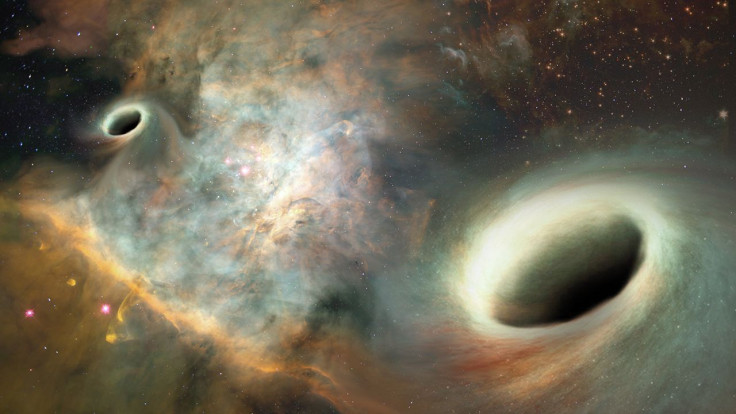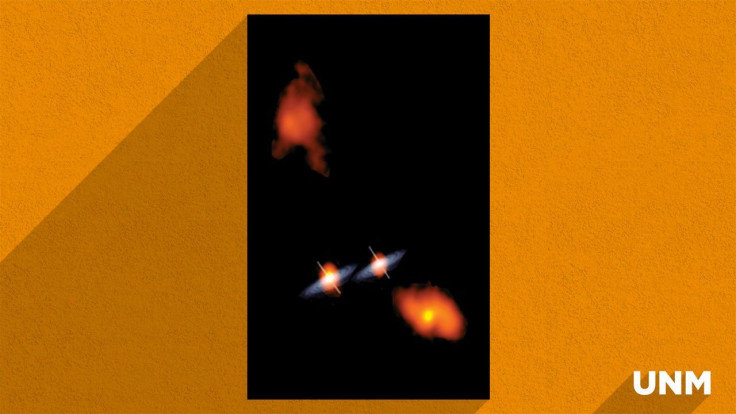Astronomers Verify Existence Of Orbiting Supermassive Black Holes

A galaxy 750 million light-years away from the Earth has not one but two supermassive black holes at its center and they form a binary system, with one orbiting the other. The discovery, announced Tuesday in a paper published in the Astrophysical Journal, is the first confirmation of orbital motion between two supermassive black holes, even though the phenomenon has been theorized for a long time.
Greg Taylor, a professor at the University of New Mexico and a co-author of the paper, said in a statement on the university’s website: “For a long time, we’ve been looking into space to try and find a pair of these supermassive black holes orbiting as a result of two galaxies merging. Even though we’ve theorized that this should be happening, nobody had ever seen it until now.”
Read: 4 Black Hole Images From NASA: Portraits Of The Universe’s Best Killer
The galaxy where this cosmic dance is taking place is called 0402+379, and the two dancing objects together have a mass of 15 billion times the sun. The massive size of the two black holes makes their orbital period extremely long, at about 24,000 years. Consequently, the team that has been observing them for 12 years has not seen even a slight curvature in the orbit.
Lead author of the paper, Karishma Bansal, is a graduate student at the University, and in the statement, she said of the discovery: “As I learned there was data going back to 2003, we plotted it and determined they are orbiting one another. It’s very exciting.”
She added it will be another three or four years before the team makes more observations of the binary supermassive black hole system to plot its precise orbit.
Putting the size of the orbit and its observation from Earth in perspective, Roger W. Romani, professor of physics at Stanford University and member of the research team, said in the statement: “If you imagine a snail on the recently-discovered Earth-like planet orbiting Proxima Centauri — 4.243 light-years away — moving at 1 cm a second, that’s the angular motion we’re resolving here.”
In a statement on Stanford’s website, Bansal said: “The black holes are at a separation of about seven parsecs, which is the closest together that two supermassive black holes have ever been seen before.”
The discovery is significant because it could tell us a lot about both supermassive black holes and the galaxies they inhabit. And somewhat closer home, it could also give us a glimpse of where our home galaxy, the Milky Way, could be headed in the future. The nearby Andromeda galaxy, which like the Milky Way, has a supermassive black hole at its center, is on a collision course with us. So what is being observed in 0402+379 now could be happening here in a few billion years.
Taylor explained in the statement: “Supermassive black holes have a lot of influence on the stars around them and the growth and evolution of the galaxy. So, understanding more about them and what happens when they merge with one another could be important for our understanding of the universe.”

Read: Black Hole vs. Supernova: How Each Could Kill You In Space
The observations were made using the Very Long Baseline Array (VLBA), a series of 10 radio telescopes across the country, designed and built by the National Radio Astronomy Observatory (NRAO).
“What we’ve been able to do is a true technical achievement over this 12-year period using the VLBA to achieve sufficient resolution and precision in the astrometry to actually see the orbit happening. It’s a bit of triumph in technology to have been able to do this,” Taylor said.
The paper was titled “Constraining the Orbit of the Supermassive Black Hole Binary 0402+379.” Robert Zavala from the U.S. Naval Observatory and A.B. Peck from the Gemini Observatory and NRAO also contributed to it.
© Copyright IBTimes 2024. All rights reserved.





















